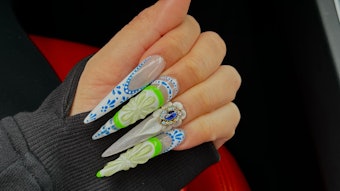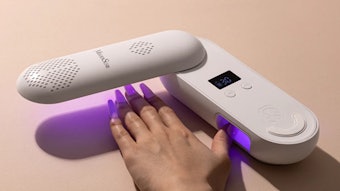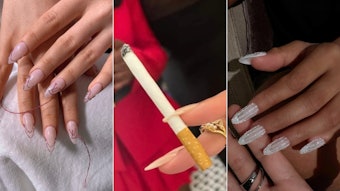
CND co-founder Jan Arnold shares her advice to elevate your current pedicure services to spa treatments.
The first ever systemic approach to spa services for feet was created in 1997, which expanded a new channel of business for the nail professional and exciting new services for the salon client. Until then, salons only focused on the hands and nails, and total professional industry revenue for foot care was at less than 2% of total. Nail professionals were reluctant to embrace foot care services until a revolutionary system of products were introduced called “marine spa pedicure,” trademarking “spa pedicure.” This new natural, aromatic and systemic approach encouraged the adoption of the pedicure and ensured it became a part of regular care year-round. The original system featured renewable ingredients from the sea, and it transformed the nail industry and salon service offerings. Within five years, spa pedicures became a must-have service, especially in combination with the manicure service, for the mani/pedi combo.
What Is Spa?
In looking at the spa revolution of the 1990s and early 2000s, the word spa implied health and wellness. Freestanding spas were considered wellness clinics or lifestyle centers. Today, spa services are seen as an essential part of personal well-being and health improvement. In the nail profession, spa services extend beyond nails, as for some, it can be the only time they can exhale, catch their breath and relax, while for others it’s a time to exhilarate and energize. These services are extraordinary for the client and command a premium price by the nail professional.
Goals Of the Spa Pedicure Service
Spa pedicure services optimize wellness for the feet and legs, as well as the entire body experience. Spa services range from very quick and simple add-on treatments to a comprehensive journey of sensorial essence and wellness. Taking care of your feet is important because they are the foundation of the body and our connection to Earth. Good foot care includes wearing comfortable shoes, trimmed toenails, calluses that are under control and regular pedicures. Proper foot care can help prevent potential foot problems and ensure activity and mobility for a lifetime.
From Spa To Serious Skin Care
The evolution of the service has gone from a feel good experience to serious skin care with foot/leg treatments featuring skin care essentials for results that can be both seen and felt. The treatment is introduced in service by a trained nail professional, and then the recommended treatment plan goes home with the client as their new daily beauty regimen. This daily routine will help preserve the results and continue the benefits for intensive hydration and moisturization between salon services. It is critical that the nail professional explain this new regimen as a treatment plan that requires participation and commitment. In preparation for the treatment, the nail professional will analyze the condition of the skin then design a personalized treatment plan for each client. During this consultation, it is important to analyze the need, ask questions about service intention and recommend a plan that includes home care.
Some important ingredients in your elevated treatment offering should include prebiotic ingredients to promote a healthy microbiome, hydrating and moisturizing ingredients as well as great physical and chemical exfoliators. Let’s review each category.
Prebiotic treatment: Prebiotic complexes for feet can be formulated with alpha-glucan oligosaccharide and beta-Glucan, which are sugars that act as the “food” for the beneficial microorganisms of the skin. The skin microbiome is an ecosystem of bacteria on the skin’s surface. It provides protection against pathogens that could affect skin and overall health. Prebiotics are microorganisms that rebalance the skin microflora by encouraging growth of beneficial bacteria, thereby promoting a mutually supportive skin/microbe balance. When the microbiome is balanced, skin looks and feels healthy. Think of the microbiome as the “guardian to the skin,” protecting against pathogens. Feeding the microbiome of our feet/legs is best delivered daily for optimal results.
Hydration and moisturization: Your treatments should also include hydration and moisturizing ingredients. Hydration in skin care means applying water or water-binding ingredients to your skin, such as glycerin. The humectants attract water in from the environment or skin then bind them to the skin to help protect the skin’s barrier. Moisturization in skin care means to lubricate the skin with emollients, thereby reducing dryness and transepidermal water loss. Sealing in moisture will help prevent water loss and bind it to the skin, forming a protective lipid barrier to the outer most layer of skin. Lipids are naturally forming; however, the addition of ingredients such as shea butter and naturally derived oils, such as avocado, sweet almond, rice bran, sunflower oil and soybean oil, will boost the benefits.
Exfoliation and cleansing: Include in your treatment both a physical and chemical exfoliator. Physical exfoliation is accomplished with sea salts, citric acid and sodium citrate micro crystals. Chemical exfoliation is accomplished with urea, as well as alpha hydroxy acids (AHAs), such as glycolic, lactic and citric acids. Urea increases moisture in the skin by softening the top layer, effectively exfoliating calluses. This effect helps the dead skin cells fall off and helps the skin keep more water in. AHAs help surface skin cell turnover through exfoliation. Cleansing and deodorizing ingredients can include eucalyptus globulus leaf oil to deodorize and tea tree leaf oil to cleanse.
Treatment Ritual Overview
Create a 360˚ approach to every personalized treatment for the client. Impart a sense of introduction, treatment and a commitment to the recommended daily regimen. Using a ritual approach elevates each step of the treatment and develops consistency for each time the client returns. Practice a treatment ritual that includes three phases: pre-treatment, treatment and post-treatment.
Pre-Treatment Phase: Set the Stage
The nail professional’s success is directly tied to the salon environment. It should represent cleanliness, safety and comfort. A pristine environment sends a professional message and evokes confidence. It sends a clear signal of commitment that the salon not only looks clean, but it also meets the highest standards of cleanliness. During the treatment, absolute cleanliness and a safe environment are an excellent way to show clients concern for their well-being. Many states now require that a logbook or other record be kept of each cleaning and disinfection procedure. Clients might also want to see this record. Salon wellness demands careful practice of universal sanitation and service protocols. All aspects of these practices are universal and standard procedure for all nail professionals.
Treatment: Set the Mood
Establishing a calm and serene environment will set the stage for the client. This is the time to shape the client’s experience. Start by keeping the guest area sanitary, pristine and free of clutter. Then, identify their mood, making minor adjustments to the environment if needed.
Conduct the consultation: The goal is to satisfy the client’s needs with the right solution. Assess the client’s needs by using a consultation card. Consultations provide you an opportunity to get to know your client, analyze their nails, learn about their lifestyle, understand their goals for their nails, determine which service is best for your client and recommend the right products for at-home care. Using the information from the consultation, the nail professional recommends the service treatment for the client. Every recommendation must meet the individual needs of the client. If needed, explain the need for a soakless service.
Pre-set treatment ritual trays with product bowls and service accessories for each appointment: Once the treatment protocol has been determined from the consultation, it’s easy to scoop or pump-out enough product onto the pre-set tray while the client is washing their hands or soaking their feet.
Post-Treatment: Customized Nail and Skin Care Regimen
Think of the client relationship as a partnership. How the client maintains their hands and feet not only affects the longevity of the treatment but also determines how effective and successful their next treatment will be. It’s important to note that treatments shouldn’t end the moment the client walks out the salon door. Create a personalized at-home skincare regimen with step-by-step instructions to ensure the client has everything needed to maximize treatment benefits.
The Business of a Professional, Skin Care-based Foot & Leg Treatment
Elevated skin care treatments demand an elevated service charge. The service is recommended at premium pricing of 35–45% over the basic mani/pedi treatment, and retail products must be available to travel home with the client for the best results. Display the system near the nail treatment room or at the front desk of the salon/spa and include the products the client must use at home in the treatment recommendations. Home care products are recommended to be marked-up over salon cost by 50–75%. Determine the best profit margin for your salon based on the salon location, overhead and business model.
Utilize treatment time to educate the client on the ingredient story behind the service and the benefits of building a healthy microbiome for the limbs. Inspire commitment and make a partnership with the client to reach new levels of lush for their skin care needs. Maximize today’s amazing science to elevate your spa pedicure services to new skin care heights as your clients adopt the treatment as their new daily beauty regimen!
About the Author:
Jan Arnold is the co-founder and style director of CND. Her father, Dr. Stuart Nordstrom, was the brilliant dentist and organic chemist whose discoveries launched the company in 1979. Her family built CND on a commitment to advancing the state of the industry through groundbreaking innovation and world-class education. Jan is a founding Board Member of Beauty Changes Lives (BCL), a foundation committed to elevating, educating and exposing the richness of a career in professional beauty. She led an effort to raise scholarship donations for aspiring nail professionals though the creation of the BCL CND Tippi Hedren Nail Scholarship Fund, which has raised $250,000 to-date along with $150,000 in Advanced Scholarships for active and licensed nail professionals.














